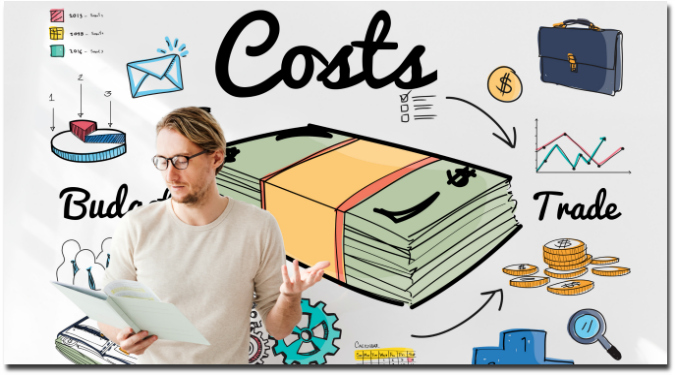How to Better Account for Hidden Costs in your Business
Developing accurate projections of capital requirements is a tremendous challenge for new entrepreneurs because startup ventures are often associated with great uncertainty.

Why?
Because many costs are impossible to know with certainty until assets are ready to be purchased, and this might come years in the future. Furthermore, significant expenses are often easy to forget about due tothe excitement associated with bringing a new product to market.
Entrepreneurs who take the time to make conservative cost estimates before seeking investors (or paying out of your own pocket) and making long-term commitments can significantly increase the chances of success.
And even if you figure out ways to minimize those costs, you must account for them not just as costs now, but costs for the future.
Here are eight cost categories to consider so you can learn how to better account for hidden costs in your business.
1. Cost of Real Estate
Real estate is one of the most significant expenses that businesses incur, but it is also essential for operations in almost all industries.
Established businesses rarely have problems with real estate expenses because these overhead costs can be incorporated into the price of products, and other firms in the competitive environment have to do the same. However, since startups often take two years or more to break even, real estate costs can threaten a new company’s prospects of survival.
Entrepreneurs must carefully plan the timing of real estate purchases while also assuring flexibility.
Alternative options for real estate, such as working out of an entrepreneur’s home or asking employees to work off site, are critical for minimizing the capital cost and uncertainty associated with launching a new venture.
What can you do to minimize your current and projected Real Estate costs?
2. Financing Costs
Many entrepreneurs are unwilling to cede equity so they can retain more of the long-term payoff they expect from their new venture. Unfortunately, loans are usually the only alternative to equity-based financing, and interest rates can be very high for uncertain startups. Moreover, loans might not even be available to high-risk ventures due to investor perceptions of extraordinary risk.
Even when entrepreneurs are willing to find equity-based funding, they often make the mistake of waiting too long to find investors, and few equity investors are willing to give money to an uncertain startup that is on its last leg.
Therefore, entrepreneurs should aim to find financing early and, depending on the degree of risk associated with the venture, consider offering equity instead of encumbering their books with heavy liabilities.
Have you identified the top 3 financing methods available to you, and are you beginning to prepare to use them?
3. Paying Staff Before Reaching Profitability
Almost all of the world’s most successful companies were started by a team of driven entrepreneurs who drew very little from their startup before reaching profitability.
That’s because investors are almost never willing to supply enough upfront capital for dozens of employees to be put on payroll before a venture breaks even.
Entrepreneurs should offer equity as much as possible to avoid having to use scarce initial funds to pay the salaries of skilled employees. Offering equity can also significantly increase the incentive for employees to work harder to achieve results.
The combination of more employee output and lower immediate costs means that new businesses can have more funds available to dedicate to further growth and innovation.
Equity compensation, therefore, is often essential for reaching investor expectations of capital allocation efficiency when launching a new venture.
Have you decided how much equity you’re willing to give up at different stages of your business?
4. Cost of Growth
The actual logistics associated with growth are much more expensive than many entrepreneurs intuitively believe. Here are some examples:
- moving to a larger office might entail substantial early termination fees from the previous lease agreement, and some furniture items might have to be replaced after moving.
- Entrepreneurs might also purchase expensive machinery only to find that more expensive machines are needed instead.
- Systems that got you where you are today likely won’t be able to handle where you are tomorrow. These more robust systems, such as tools and software, will cost more (e.g., the larger your email list, the more it costs to maintain it).
The total costs associated with growth are often impossible to predict, so entrepreneurs sometimes have to rely on arbitrary allocations that still might not account for everything.
Calculating a conservative estimation of the costs associated with growth is critical for rapidly growing ventures to avoid the need for additional funding.
Are you considering what happens in 1-2 years when you’ve outgrown where you are now?
5. Cash Flows and Timing
When rapidly growing startups fail, they almost always do so because of cash flow mistakes. A major customer might fail to make a payment, or an astronomical cost might become payable immediately.
Startups with substantial capital reserves can manage the risks associated with unforeseen expenses, but those without such a margin of safety run the risk of failing.
Entrepreneurs should keep in mind that competitors might attempt to use limited capital reserves against them, and therefore spoil their prospects of success. For example, a competitor might try to take away key customer accounts at the worst possible time.
Entrepreneurs should keep track of liquid capital to ensure that sufficient funds would be available to weather the storm of a cash flow crisis.
Are you tracking your cash flow? What are the weaknesses in the income coming into your business and what can you do to counteract those weaknesses?
6. Aggregate Cost of Minor Expenses
Minor expenses can add up in ways that are difficult to project, because small purchases are often too numerous and uncertain to account for in projections. Small purchases might range from the cost of office parties to minor machine modifications.
Since some small purchases can be planned for, entrepreneurs should take the time to account for as many of them as possible in their business plan.
As with the cost of growth, arbitrary allocations might be necessary to account for unforeseeable minor expenses.
Asking for more funding from the beginning is always better than running out of capital, so entrepreneurs should be conservative when projecting the aggregate cost of minor expenses in cost projections that will be shown to investors.
Have you added up the costs of your minor expenses and allocated enough for them?
7. The Experience Curve
Competing firms are usually able to achieve significant cost reductions each year in established industries due to a reduction of overall capital requirements. However, startups leading the frontier of new innovation rarely have enough time or money to realize scale economies before going to market.
Entrepreneurs, therefore, must plan conservatively for costs to ensure that sufficient demand will exist if products will need to be priced higher.
Many startups fail simply because their products cannot be sold at a profitable price point before running out of liquid capital.
Conservative projections of experience curve effects can be determined by consulting seasoned experts in a similar industry.
Can you survive the startup costs long enough to reap the benefits of experience? How do you know?
8. Unforeseen Expenses
Entrepreneurs must be vigilant to prepare for unforeseeable expenses because they can appear at any time. Although unforeseen expenses are impossible to project by definition, the chances of them appearing can be almost eliminated through sufficient planning.
Individuals with experience launching similar ventures and dealing with similar products or services are a critical source of assistance for projecting unforeseeable costs.
Experienced entrepreneurs can often point out costs they failed to plan for, or unintuitive expenses that are almost certain to be incurred.
Startups grounded in solid cost projections are far more likely to succeed than businesses that attempt to precisely estimate an uncertain future.
Have you consulted with someone who’s done what you’re doing and can help you mitigate unforeseen expenses?
And finally…
While answering all of these questions may seem overwhelming, if you have the discipline and forethought to consider each of them and then check with your mentor or mastermind group, you’ll be way ahead of your peers and you will have taken important steps to build a long-term, stable, business.
Which one (or more) of these areas affect you the most? And what will you be doing about it?


















